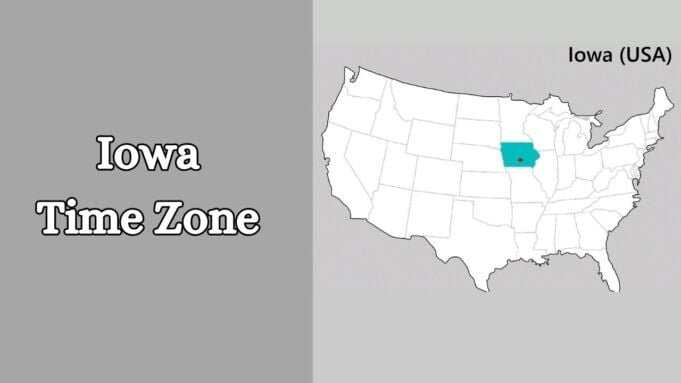Are you planning a trip to Iowa and wondering about the time zone? Or are you a resident of Iowa who wants to know the current local time? Iowa, located in the Midwest region of the United States, follows the Central Time Zone. But did you know that Iowa has a history of observing different time zones in the past?
In the early 20th century, Iowa was divided between the Central and Eastern times. However, this caused confusion and inconvenience for businesses and transportation. In 1918, the Uniform Time Act was passed, which standardized time zones across the United States. Since then, Iowa has consistently followed the Central Time Zone.
In this article, you will learn everything you need to know about the Iowa Time Zone, including the current local time, daylight saving time changes, and how it compares to other time zones in the United States. By the end of this article, you will better understand the Iowa Time Zone and be able to plan your travels or daily schedule accordingly.
History of Timekeeping in Iowa
The time zone history of Iowa is closely tied to the broader changes in timekeeping practices in the United States. Initially, time was determined locally, with towns setting their clocks based on the position of the sun. This method was practical in a predominantly agrarian society, where each locality operated on its schedule.
However, the advent of railroads in the 19th century necessitated a more standardized approach to timekeeping. The multiple local times became problematic for scheduling trains and maintaining efficiency across different cities and towns. In response, American and Canadian railroads established a standardized system of time at a meeting in Chicago on November 18, 1883. This system divided the continent into four time zones: Eastern, Central, Mountain, and Pacific.
Iowa, situated in the heart of the Midwest, was placed in the Central Time Zone. This placement was based on the meridians passing through certain key locations, which for the Central Time Zone, was primarily the 90th meridian west of Greenwich. This allowed for a more organized and unified scheduling system not only for railroads but also for communication and commerce.
Over the years, the use of time zones was formalized beyond railroad companies. The Standard Time Act of 1918, also known as the Calder Act, legally established standard time zones in the U.S. This Act also instituted daylight saving time, though its application has varied over the years.
Today, Iowa remains in the Central Time Zone, observing daylight saving time from the second Sunday in March until the first Sunday in November, which shifts the clock one hour forward to better utilize the evening daylight.
Understanding the history of time zones in Iowa provides insight into the development of national timekeeping standards and reflects the state’s integration into the national economic and transportation frameworks. This historical perspective is essential for appreciating how timekeeping practices have evolved to meet the needs of modern society.
What time zone is Iowa?
Iowa is located in the Central Time Zone (CT) of the United States. This positioning means that the standard time in Iowa is six hours behind Coordinated Universal Time (UTC-6) during the standard period, and five hours behind (UTC-5) when daylight saving time is in effect. Daylight saving time in Iowa begins on the second Sunday in March and ends on the first Sunday in November, during which clocks are moved one hour forward to extend the evening daylight.
This time zone alignment places Iowa in the same time zone as many of its Midwestern neighbors, ensuring consistency for commerce, communication, and travel within the region.
How Many Time Zones are there in Iowa?
Iowa is entirely within the Central Time Zone, and there are no other time zones in the state. This means that the time in Iowa is the same throughout the state, and there is no need to adjust your clocks when traveling.
The Central Time Zone covers many parts of the United States, including 20 states. It is also known as the North American Central Standard Time or NACST. Many cities and towns in the country’s Midwest, South, and Great Plains regions use the zone.
What Time is It in Iowa, AM or PM?
The time in Iowa is displayed in the 12-hour format, with AM and PM suffixes. For example, if the current time in Iowa is 2:30 PM, it means 2 hours and 30 minutes past noon. Similarly, if the current time in Iowa is 2:30 AM, it means 2 hours and 30 minutes past midnight.
Notably, the Eastern Time Zone (ET) is one hour ahead of Iowa and the rest of the Central Time Zone. Thus, if it is 3:00 PM in New York, Iowa is at 2:00 PM.
If you are traveling to Iowa or have friends or family in Iowa, it is important to know the current local time in Iowa to ensure everything is clear. You can easily check the current time in Iowa on your phone or computer by searching for “current local time in Iowa” on Google or any other search engine.
Iowa Time Zone Impact on Daily Life
If you live in Iowa, you will likely be in the Central Standard Time (CST) zone. The Iowa time zone is one hour behind the Eastern Standard Time (EST) and two hours ahead of the Pacific Standard Time (PST). The time zone significantly impacts various aspects of daily life, including business operations, agriculture schedules, school timings, and broadcasting timelines.
Business Operations
Iowa is home to several small and large businesses, and the time zone plays a crucial role in their operations. If you are running a business in Iowa, you must be aware of the time difference between your state and other states in the United States. You may need to adjust your business hours to ensure you are available to customers and clients in other time zones.
Agriculture Schedules
Agriculture is a significant industry in Iowa, and the time zone affects the schedules of farmers and other agriculture-related businesses. The time zone also affects the timing of daylight saving time, which can significantly impact the agricultural sector. Farmers must adjust their schedules to make the most available daylight hours.
School Timings
If you are a student or a parent of a student in Iowa, you need to be aware of the time difference between your state and other states. The time zone can affect school timings, especially if you attend an online school or take classes from an out-of-state institution. You may need to adjust your schedule to ensure you attend classes at the right time.
Broadcasting Timelines
Broadcasters in Iowa need to be aware of the time difference between their state and other states. The time zone can affect the timing of live broadcasts, especially if they are broadcasting to other states or countries. Broadcasters must adjust their schedules to ensure they are broadcasting at the right time.
Does Iowa Change Their Clocks?
Yes, Iowa changes its clocks twice yearly to observe Daylight Saving Time (DST). The clock is moved forward by one hour in the spring and back by one hour in the fall. This practice aligns with other states in the United States that observe DST.
The time change occurs on the second Sunday in March at 2:00 am when clocks are moved forward by one hour. This marks the beginning of DST in Iowa. The clocks are then moved back by one hour on the first Sunday in November at 2:00 am. This marks the end of DST in Iowa.
Where does the time change in Iowa?
In Iowa, the time changes when Daylight Saving Time (DST) begins and ends. During DST, the clocks are set one hour ahead in the spring and one hour back in the fall. The time change in Iowa occurs simultaneously with the rest of the United States.
Iowa is in the Central Time Zone, six hours behind Coordinated Universal Time (UTC-6). Iowa observes Central Daylight Time (CDT) during DST, five hours behind UTC (UTC-5).
It is important to note that not all areas of the state observe DST. Some counties in Iowa have opted out of DST and do not change their clocks during the year. These counties include Adair, Adams, Cass, Clarke, Decatur, Fremont, Harrison, Mills, Montgomery, Page, Pottawattamie, Ringgold, Shelby, Taylor, and Union.
Comparison with Other US Time Zones
Compared to other US time zones, the Central Time Zone is ahead of the Pacific Time Zone (PT) by two hours and behind the Eastern Time Zone (ET) by one hour. The Mountain Time Zone (MT) is one hour behind the Central Time Zone.
The Central Time Zone is used in 20 US states, including Iowa, and covers much of the country’s land area. Major US cities like Chicago, Houston, Dallas, New Orleans, and Minneapolis use the Central Time Zone.
Traveling from the Eastern Time Zone to the Central Time Zone will lose one hour. For example, 10:00 AM in New York City (ET) will be 9:00 AM in Iowa (CT). On the other hand, traveling from the Pacific Time Zone to the Central Time Zone, will take two hours. For example, 10:00 AM in Los Angeles (PT) will be 12:00 PM in Iowa (CT).
Frequently Asked Questions (FAQs)
What is the standard time zone for Iowa?
The standard time zone for Iowa is Central Standard Time (CST), which is 6 hours behind Coordinated Universal Time (UTC-6).
How do I convert Iowa’s time zone to Greenwich Mean Time (GMT)?
To convert Iowa’s time zone to Greenwich Mean Time (GMT), add 6 hours to the current time in Iowa. For example, if it is 3:00 PM in Iowa, it would be 9:00 PM in GMT.
Can you compare Iowa’s time zone with Eastern Standard Time (EST)?
Iowa’s time zone is one hour behind Eastern Standard Time (EST). For example, if it is 2:00 PM in Iowa, it would be 3:00 PM EST.
Does Iowa observe Daylight Saving Time, and when does it change?
Yes, Iowa observes Daylight Saving Time (DST). DST starts on the second Sunday of March and ends on the first Sunday of November.
What is the time difference between Iowa and Illinois?
The time difference between Iowa and Illinois is one hour. Iowa is in the Central Time Zone, while Illinois is in the Central and Eastern Time Zones.
How can I set the correct time zone for Iowa on my iPhone?
To set the correct time zone for Iowa on your iPhone, go to Settings > General > Date & Time > Time Zone and select “Central Time (US & Canada)”. This will ensure that your iPhone displays the correct time for Iowa.
Conclusion
Iowa is located in the Central Time Zone in the United States. It observes Daylight Saving Time, which begins on the second Sunday of March and ends on the first Sunday of November. During Daylight Saving Time, the time in Iowa is UTC-5, while Standard Time is UTC-6.
It is important to keep track of the time zone changes to avoid confusion when scheduling appointments or making travel plans. Whether you are a resident of Iowa or a visitor, understanding the time zone is crucial.
I hope this article has provided valuable information on the Iowa Time Zone and its significance. Remember to share this article with your friends and family, and leave a comment below if you have any questions or feedback.















